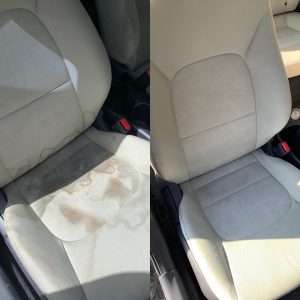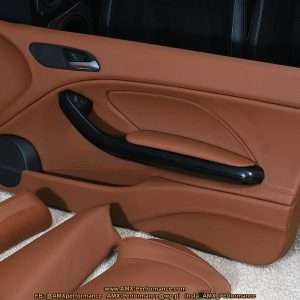Is your car interior looking a little…tired? Maybe those seats have seen better days, or perhaps you’re just craving a fresh, personalized look. Before you shell out a fortune at an upholstery shop, consider tackling the project yourself! DIY car interior upholstery can be a rewarding and cost-effective way to breathe new life into your vehicle. It might seem daunting, but with the right tools, materials, and a little patience, you can achieve professional-looking results. Let’s dive into how you can transform your car’s interior without breaking the bank.
Planning Your DIY Car Interior Upholstery Project
Before you even think about picking up a needle and thread, careful planning is crucial. This stage will determine the success (and sanity!) of your DIY car interior upholstery endeavor. What exactly do you want to change? Are you just reupholstering the seats, or are you tackling the door panels and headliner too?
Assessing the Damage and Defining Your Scope
Take a good, hard look at your car’s interior. Identify the areas that need the most attention. Are there rips, tears, stains, or just general wear and tear? Knowing the extent of the damage will help you determine the amount of fabric you’ll need and the complexity of the project. Don’t forget to factor in extra material for mistakes – trust me, they happen!
Choosing the Right Upholstery Fabric
The fabric you choose will significantly impact the look and feel of your car’s interior. Consider these factors:
- Durability: Car interiors endure a lot of wear and tear, so opt for a durable fabric like vinyl, leather, or a heavy-duty synthetic.
- Cleanability: Spills happen! Choose a fabric that’s easy to clean and maintain.
- Aesthetics: Select a fabric that complements your car’s style and your personal taste.
- Cost: Fabric prices can vary widely, so set a budget and stick to it.
Pro Tip: Order fabric samples before making a final decision. This allows you to see and feel the fabric in person and ensure it matches your expectations.
Gathering Essential Tools and Supplies for Car Interior Upholstery
Having the right tools will make the upholstery process much smoother and more efficient. Here’s a basic list:
- Upholstery fabric
- Upholstery thread
- Sewing machine (heavy-duty recommended)
- Upholstery needles
- Staple gun and staples
- Pliers
- Screwdrivers
- Measuring tape
- Scissors or rotary cutter
- Marker or chalk
- Seam ripper
- Foam padding (if needed)
Step-by-Step Guide to DIY Car Interior Upholstery
Alright, you’ve planned, prepped, and gathered your supplies. Now, let’s get to the fun part: the actual upholstery! Remember to take your time and don’t be afraid to ask for help if you get stuck. This is a learning process, and patience is key.
Removing the Old Upholstery
Carefully remove the old upholstery from the seats, door panels, or headliner. Pay close attention to how the original fabric was attached, as this will serve as a guide for reattaching the new fabric. Use a seam ripper to carefully remove any staples or stitching.
Creating a Pattern for Your New Upholstery
This is where your old upholstery comes in handy! Use it as a template to cut out your new fabric. Lay the old fabric pieces on top of the new fabric, trace around them with a marker or chalk, and then cut them out. Remember to add extra seam allowance (about 1/2 inch) for sewing.
Sewing the New Upholstery
Using your sewing machine, sew the new fabric pieces together, following the pattern of the original upholstery. Be sure to use a strong upholstery thread and a stitch length appropriate for the fabric you’re using. Take your time and sew carefully to ensure a professional-looking finish.
Interesting Tip: Consider using a walking foot attachment for your sewing machine. This helps feed multiple layers of fabric evenly, preventing slippage and ensuring a smooth, even seam.
Attaching the New Upholstery
Once the new upholstery is sewn together, it’s time to attach it to the seat frame, door panel, or headliner. Use a staple gun to secure the fabric in place, following the original attachment points. Pull the fabric taut as you staple to avoid wrinkles and sagging. Use pliers to remove any stray staples.
Troubleshooting Common DIY Car Interior Upholstery Problems
Even with careful planning and execution, you might encounter some challenges along the way. Don’t panic! Here are some common problems and how to fix them.
Dealing with Wrinkles and Sagging
Wrinkles and sagging can occur if the fabric isn’t pulled taut enough during installation. To fix this, remove the staples in the affected area, pull the fabric tighter, and re-staple. You may also need to add extra foam padding to fill out any gaps.
Fixing Uneven Seams
Uneven seams can be caused by incorrect cutting or sewing. If the seam is only slightly uneven, you may be able to adjust it by carefully stretching or easing the fabric. If the seam is significantly uneven, you may need to re-sew it.
Addressing Tears and Rips
If you accidentally tear or rip the fabric, you can often repair it with a patch. Cut a piece of fabric slightly larger than the tear, apply fabric glue to the edges, and press it firmly onto the tear. For a more durable repair, you can also sew the patch in place.
DIY Car Interior Upholstery: Knowing When to Call a Pro
While DIY upholstery can save you money, some projects are best left to the professionals; If you’re dealing with complex patterns, intricate stitching, or significant structural damage, it’s probably wise to consult with an experienced upholsterer. They have the skills and equipment to handle these challenges and ensure a high-quality result. Sometimes, peace of mind is worth the investment!
Frequently Asked Questions About DIY Car Interior Upholstery
So, there you have it! DIY car interior upholstery is a project that can transform your vehicle and give you a sense of accomplishment. It’s not always easy, but with the right preparation and a can-do attitude, you can achieve amazing results. Remember to take your time, be patient, and don’t be afraid to experiment. Your car will thank you for it, and your wallet will too. Now, go forth and create the car interior of your dreams!




